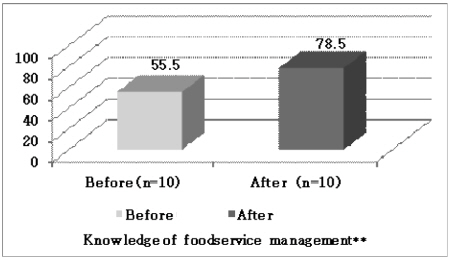Articles
- Page Path
- HOME > Korean J Community Nutr > Volume 17(1); 2012 > Article
-
Original Article
- Assessment of the Support Program of Foodservice Management for Community Child Centers in Jeollanam-do, Korea
- Sooyoun Kwon, Youngmi Lee, Soyoung Kim, Jinyoung Kim, Jihyun Yoon
-
Korean Journal of Community Nutrition 2012;17(1):91-100.
DOI: https://doi.org/10.5720/kjcn.2012.17.1.91
Published online: February 29, 2012
1)Department of Food and Nutrition, Seoul National University, Seoul, Korea.
2)Geumcheon-gu Center for Child-care Foodservice Management, Seoul, Korea.
3)Research Institute of Human Ecology, Seoul National University, Seoul, Korea.
- Corresponding author: Jihyun Yoon, Department of Food and Nutrition, Seoul National University, 1 Gwanak-ro, Gwanak-gu, Seoul 151-742, Korea. Tel: (02) 880-8750, Fax: (02) 884-0305, hoonyoon@snu.ac.kr
Copyright © 2012 The Korean Society of Community Nutrition
- 948 Views
- 0 Download
- 2 Crossref
Figure & Data
REFERENCES
Citations

- Investigation of the Management of Foodservice Facilities inCommunity Child Centers in Daegu and Gyeongbuk Area
Suk-Hyeon Park, Hyeon-A Jung
Journal of the East Asian Society of Dietary Life.2017; 27(4): 459. CrossRef - Food Service Status at Community Child Care Centers in Busan
Jeong-Sook Lee
Journal of the Korean Dietetic Association.2014; 20(1): 50. CrossRef

Fig. 1
General characteristics of the responding community child centers and foodservice personnel
General characteristics of the responding children
Number of dishes and food items per meal in community child centers before and after the foodservice management support program
1) by paired t-test
Patterns of food groups per meal in community child centers before and after the foodservice management support program
1) G = grain, M = meat, V = vegetable, F = fruit, and D = dairy product group: 1 = food group (s) present, 0 = food group (s) absent
For example GMVFD = 11100 indicate that grain, meat and vegetable were provided and fruit and dairy product groups were not provided.
2) by chi-square test
3) Others included '10110', '10101', '10111', 11010', and '11000'
Frequency of food groups not served in meals in community child centers before and after the foodservice management support program
1) by chi-square test
Foodservice personnel's level of perceived performance of foodservice management in community child centers before and after the foodservice management support program1)
1) 1 point for never, 2 points for rarely, 3 points for neutral, 4 points for usually, or 5 points for always
2) by Wilcoxon's signed-ranks test
Children's behavioral change recognized by foodservice personnels after the foodservice management support program1)
1) 1 point for really decreasing, 2 points for decreasing, 3 points for no change, 4 points for increasing, and 5 points for really increasing
Practice level of eating behavior guidelines of children in community child centers before and after the foodservice management support program1)
1) 1 point for strongly disagree, 2 points for disagree, 3 points for neutral, 4 points for agree, and 5 points for strongly agree
2) by paired t-test
Children's level of satisfaction with foodservice in community child centers before and after the foodservice management support program1)
1) 1 point for strongly disagree, 2 points for disagree, 3 points for neutral, 4 points for agree, and 5 points for strongly agree
2) by paired t-test
1) by paired t-test
1) G = grain, M = meat, V = vegetable, F = fruit, and D = dairy product group: 1 = food group (s) present, 0 = food group (s) absent For example GMVFD = 11100 indicate that grain, meat and vegetable were provided and fruit and dairy product groups were not provided. 2) by chi-square test 3) Others included '10110', '10101', '10111', 11010', and '11000'
1) by chi-square test
1) 1 point for never, 2 points for rarely, 3 points for neutral, 4 points for usually, or 5 points for always 2) by Wilcoxon's signed-ranks test
1) 1 point for really decreasing, 2 points for decreasing, 3 points for no change, 4 points for increasing, and 5 points for really increasing
1) 1 point for strongly disagree, 2 points for disagree, 3 points for neutral, 4 points for agree, and 5 points for strongly agree 2) by paired t-test
1) 1 point for strongly disagree, 2 points for disagree, 3 points for neutral, 4 points for agree, and 5 points for strongly agree 2) by paired t-test

 KSCN
KSCN










 Cite
Cite


